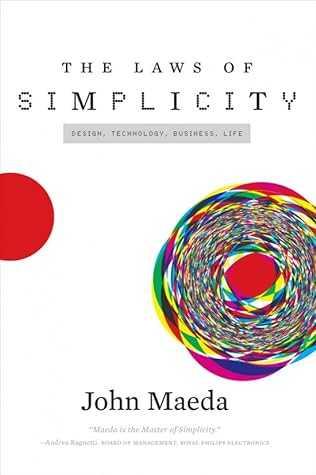Learn more about product with this collection
How to create a productive environment
The importance of self-care in productivity
How to avoid distractions
Law 1: REDUCE
The simplest way to achieve simplicity is through thoughtful reduction.
When in doubt, just remove. But be careful of what you remove.
772
14.4K reads
Reduction by the SHE Method: Shrink
Simplicity is about the unexpected pleasure derived from what is likely to be insignificant and would otherwise go unnoticed.
Fragility is an essential counteracting force to complexity because it can instil pity— which by coincidence also occurs in the word SIMPLICITY!
638
11.3K reads
Reduction by the SHE Method: HIDE
When all features that can be removed have been, and a product has been made slim, light, and thin, it’s time for the second method: HIDE the complexity through brute-force methods.
Hiding complexity through ingenious mechanical doors or tiny display screens is an overt form of deception. If the deceit feels less like malevolence, more like magic, then hidden complexities become more of a treat than a nuisance.
636
7.66K reads
Reduction by the SHE Method: Embody
EMBODY-ing quality is primarily a business decision, more than one of design or technology. The quality can be actual, as embodied by better materials and craftsmanship; or the quality can be perceived, as portrayed in a thoughtful marketing campaign.
Exactly where to invest— real or believed quality— to get maximum return is a question with no single definitive answer.
614
5.45K reads
Law 2: ORGANIZE
Organization makes a system of many appear fewer.
To do it:
- SORT: Write down on small post-it notes each datum to be SLIP-ped. Move them around on a flat surface to find the natural groupings.
- LABEL: Each group deserves a relevant name. If a name cannot be decided upon, an arbitrary code can be assigned such as a letter, number, or colour.
- INTEGRATE : Whenever possible, integrate groups that appear significantly like each other.
- PRIORITIZE: Finally, collect the highest priority items into a single set to ensure that they receive the most attention.
658
3.98K reads
Law 3: TIME
Shrinking the time of a process can sometimes only go so far, and so an alternative means to “saving” time is to hide its passage by simply removing time displays from the environment.
617
4.8K reads
Law 4: LEARN
Knowledge makes everything simpler. Learning occurs best when there is a desire to attain specific knowledge.
To teach:
- BASICS are the beginning.
- REPEAT yourself often.
- AVOID creating desperation.
- INSPIRE with examples.
- NEVER forget to repeat yourself.
- REPEAT-ting yourself can be embarrassing, especially if you are self-conscious.
- AVOID-ing desperation is something to target when learning is concerned.
- INSPIRATION is the ultimate catalyst for learning: internal motivation trumps external reward.
664
3.59K reads
Law 5: DIFFERENCES
Simplicity and complexity need each other.
Understand the duality in the world around you.
617
4.01K reads
Law 6: CONTEXT
What lies in the periphery of simplicity is definitely not peripheral.
This law emphasizes the importance of what might become lost during the design process. That which appears to be of immediate relevance may not be nearly as important compared to everything else around. Our goal is to achieve a kind of enlightened shallowness.
601
3.02K reads
The Paradox Of Lost And Found
The opportunity lost by increasing the amount of blank space is gained back with enhanced attention on what remains.
There is an important tradeoff between being completely lost in the unknown and completely found in the familiar. Too familiar can have the positive aspect of making complete sense, which to some can seem boring; too unknown can have the negative connotations of danger, which to some can seem a thrill.
616
2.6K reads
Law 7: EMOTION
Our society, systems, and artefacts require active engagement in care, attention, and feeling— the business value may not be immediately apparent. But the fulfilment from living a meaningful life is the ROE (Return on Emotion).
A certain kind of more is always better than less— more care, more love, and more meaningful actions. I don’t think I need to say anything more really. More emotions are better than less.
607
2.37K reads
Law 8: TRUST
- In simplicity we trust.
- The goal of LEAN BACK is to achieve relaxation as the desired state.
- Overconfidence is usually the enemy of greatness, and there’s little room for personal ego when pleasing a customer is the true priority.
- The more a system knows about you, the less you have to think. Conversely, the more you know about the system, the greater control you can exact.
610
2.21K reads
Law 9: FAILURE
- Some things can never be made simple.
- There’s always an ROF (Return On Failure) when you try to simplify— which is to learn from your mistakes.
- Deeming something as complex or simple requires a frame of reference.
606
2.48K reads
Law 10: THE ONE
Simplicity is about subtracting the obvious, and adding the meaningful.
- Key 1: AWAY More appears like less by simply moving it far, far away.
- Key 2: OPEN Openness simplifies complexity.
- Key 3: POWER Use less, gain more.
LIFE - Technology and life only become complex if you let it be so.
618
2.37K reads
The 10 Laws: Recap
- REDUCE - The simplest way to achieve simplicity is through thoughtful reduction.
- ORGANIZE - Organization makes a system of many appear fewer.
- TIME - Savings in time feel like simplicity.
- LEARN - Knowledge makes everything simpler.
- DIFFERENCES - Simplicity and complexity need each other.
- CONTEXT - What lies in the periphery of simplicity is definitely not peripheral.
- EMOTION - More emotions are better than less.
- TRUST - In simplicity we trust.
- FAILURE - Some things can never be made simple.
- THE ONE - Simplicity is about subtracting the obvious, and adding the meaningful.
706
2.26K reads
CURATED BY
CURATOR'S NOTE
The book presents laws that the author has created for simplifying our life, and the things we may work on, or design.
“
More like this
19 ideas
6 ideas
Always Say Less Than Necessary (48 Laws of Power)
shortform.com
15 ideas
12 Universal Laws & How To Use Them To Unlock A More Spiritual Life
mindbodygreen.com
Read & Learn
20x Faster
without
deepstash
with
deepstash
with
deepstash
Access to 200,000+ ideas
—
Access to the mobile app
—
Unlimited idea saving & library
—
—
Unlimited history
—
—
Unlimited listening to ideas
—
—
Downloading & offline access
—
—
Personalized recommendations
—
—
Supercharge your mind with one idea per day
Enter your email and spend 1 minute every day to learn something new.
I agree to receive email updates

